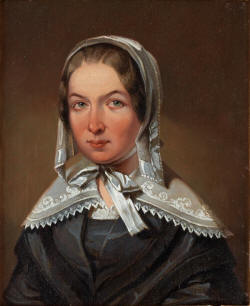

Queer Places:
Årsta slott, 137 95 Österhaninge, Sweden
 Fredrika Bremer (17 August 1801 – 31 December 1865) was a Swedish writer and feminist reformer. Her Sketches of Everyday Life were wildly popular in Britain and the United States during the 1840s and 1850s and she is regarded as the Swedish Jane Austen, bringing the realist novel to prominence in Swedish literature. In her late 30s, she successfully petitioned King Charles XIV for emancipation from her brother's wardship; in her 50s, her novel Hertha prompted a social movement that granted all unmarried Swedish women legal majority at the age of 25 and established Högre Lärarinneseminariet, Sweden's first female tertiary school. It also inspired Sophie Adlersparre to begin publishing the Home Review, Sweden's first women's magazine. In 1884, she became the namesake of the Fredrika Bremer Association, the first women's rights organization in Sweden.
Fredrika Bremer (17 August 1801 – 31 December 1865) was a Swedish writer and feminist reformer. Her Sketches of Everyday Life were wildly popular in Britain and the United States during the 1840s and 1850s and she is regarded as the Swedish Jane Austen, bringing the realist novel to prominence in Swedish literature. In her late 30s, she successfully petitioned King Charles XIV for emancipation from her brother's wardship; in her 50s, her novel Hertha prompted a social movement that granted all unmarried Swedish women legal majority at the age of 25 and established Högre Lärarinneseminariet, Sweden's first female tertiary school. It also inspired Sophie Adlersparre to begin publishing the Home Review, Sweden's first women's magazine. In 1884, she became the namesake of the Fredrika Bremer Association, the first women's rights organization in Sweden.
In the 1840s and 1850s, the Berkshire town served as a cultural center for Boston-based writers and intellectuals, including Herman Melville, Oliver Wendell Holmes, Henry Ward Beecher, and Nathaniel Hawthorne. It was also a magnet for an international coterie of progressive women reformers, among them Frances Ann (Fanny) Kemble, the British actress turned abolitionist; Harriet Martineau, the British writer on women’s rights; Fredrika Bremer, the Finnish feminist; and Anna Jameson, the British feminist and historian—all of whom engaged the young minds at the Elizabeth Sedgwick’s Lenox Academy, a progressive boarding school in the Berkshires for audacious girls.
Following her return to Sweden in November, Bremer attempted to engage its middle- and upper-class ladies in social work similar to what she had found in America and England. She co-founded the Stockholm Women's Society for Children's Care (Skyddsmödraförening or Stockholms Fruntimmersförening för Barnavård) to assist the orphans left by the 1853 Stockholm cholera outbreak [22] and the Women's Society for the Betterment of Prisoners (Fruntimmersällskapet för Fångars Förbättring) to provide moral guidance and rehabilitation of female inmates in 1854.[23] On 28 August 1854, amid the Crimean War, the London Times published her "Invitation to a Peace Alliance" alongside an editorial rebuke of its contents: a pacifist appeal to Christian women.[20] In 1856, she published her novel Hertha as A Sketch from Real Life and concluded its fictionalized assault on the 2nd-class status of adult unmarried women under the 1734 Civil Code with an appendix recounting recent Swedish court cases on the topic.[24] The work prompted the Hertha Discussion (Herthadiskussionen)[8] throughout Swedish society, reaching Parliament in 1858. There, the old system was reformed to allow (unmarried) women to petition their nearest courthouse (rather than the royal court) at the age of 25. Five years later, the legislation was revisited and all (unmarried) women were considered to automatically reach legal majority at 25. This did not affect the status of married women, who were still under the guardianship of their husbands, or divorced women or widows, who were already of legal majority. The novel also successfully raised the question of a "women's university". Högre Lärarinneseminariet, a state school for the education of female teachers, was opened in 1861.[8] Bremer was not present during the Hertha Discussion, since from 1856 to 1861 she participated in another great journey through Europe and the Levant. Leaving on 27 May 1856, she first visited Switzerland, Brussels, and Paris over the course of a year.[8] She was particularly interested in Switzerland's still-nascent "free church".[14] From September 1857, she traveled through the still-disunified Italian peninsula,[8] contrasting the Catholic practices of the Papal States with the Lutheran Swedish Church.[14] Finally, she left Messina for Malta and thence traveled to Palestine, arriving on 30 January 1859[8] and, though nearly 60 years old, tracing the life of Jesus Christ by ship, train, wagon, and horseback.[14] She stayed in Constantinople before touring Greece from August 1859 to May 1861. She reached Stockholm on 4 July 1861. Her accounts of the trip were published as Life in the Old World in six volumes from 1860 to 1862.[8] Upon her return to Sweden, she expressed her satisfaction with the reforms Hertha had prompted and took an interest in Högre Lärarinneseminariet and its students. She resumed her charitable projects and assisted with the Home Journal, the first women's magazine in Scandinavia, which Sophie Adlersparre had founded during her absence. After a final trip to Germany from July to October in 1862, she remained in Sweden the rest of her life. She was reportedly pleased with the abolition of the Diet in Sweden and of slavery in the United States.[8] She died at Årsta Castle outside of Stockholm on 31 December 1865.[8]
My published books: